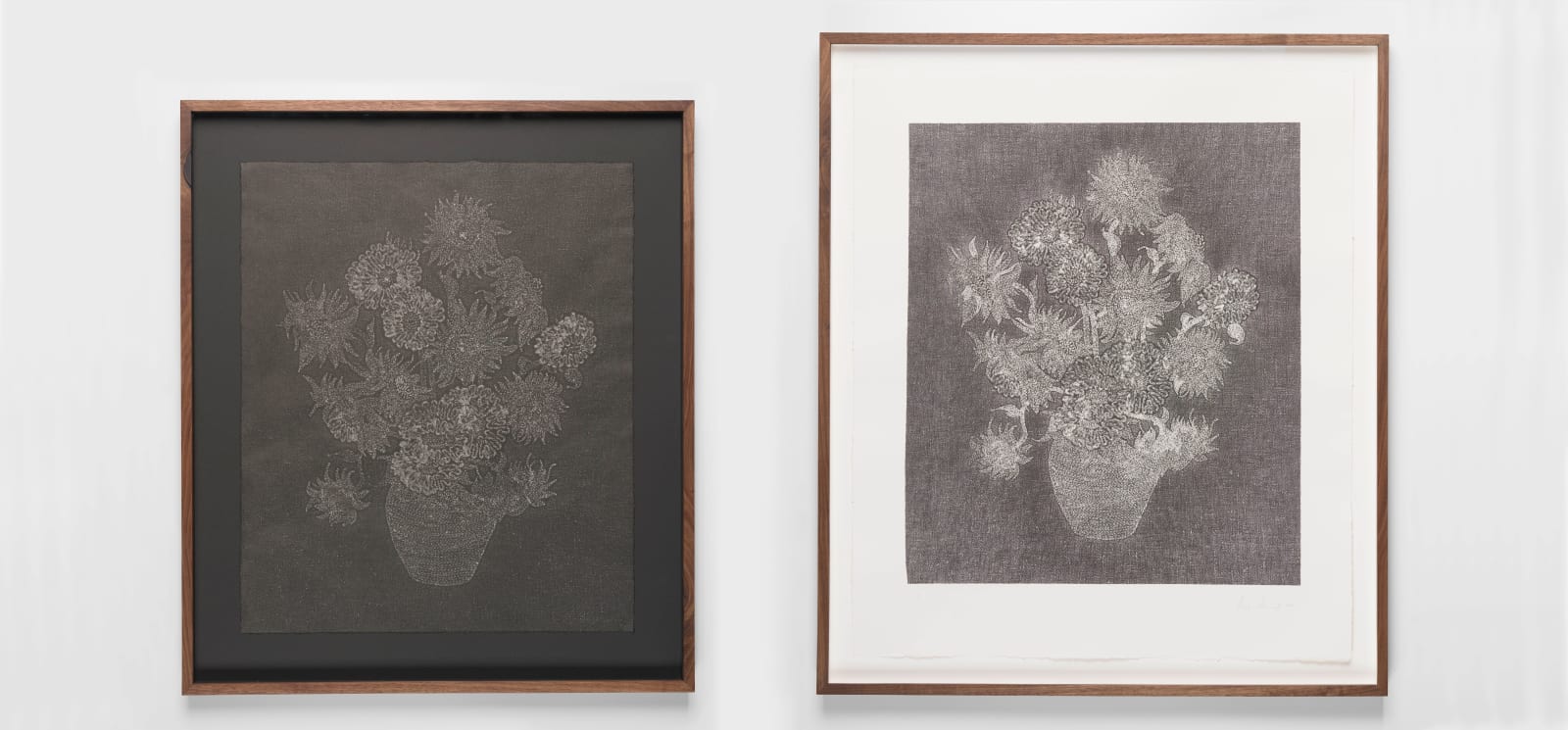 Alex Chitty
Mine (midnight), Mine (morning)
Alex Chitty
Mine (midnight), Mine (morning)Collagraph Transfer on Kozo
and Somerset Velvet White
24 x 20 inches and 30 x 25 ¼ inches (prints)
Signed and dated
Edition of 6, 2AP
 Mine (morning)
Mine (morning)
 Mine (midnight)
Mine (midnight)
 Mine (midnight), detail
Mine (midnight), detail
 Mine (morning), detail
Mine (morning), detail
Alex Chitty
Further images
In Mine (midnight), Mine (morning), collagraph transfer prints, Alex Chitty transforms imagery from one of the world’s most known paintings, Vincent van Gogh’s Fifteen Sunflowers (1888), into something novel and ethereal.
Van Gogh wrote to a friend “sunflowers are mine.” The artist’s signature floral paintings—while they failed to sell in his lifetime—are now ubiquitous. Many don’t realize that these works are memento mori, meditations on the passage of time. Within the single vase the artist painted flowers at different stages in their lifespan: half are shown in full bloom and the rest dying. In the new collagraph transfer prints, Chitty offers a further meditation on “expanses of time.” According to the artist, “Each of the two prints represents the same image as it might appear at two contrasting moments."
Chitty recontextualizes familiar objects to encourage deeper, more conscious ways of seeing. When ideas emerged for a print-based project, the artist sourced a vintage crewel embroidery of Van Gogh's painting from an independent seller on eBay. The unstretched crafted replica was placed face down onto an inked monotype plate. Two visually distinct black and white depictions of van Gogh’s sunflowers emerged through variations of pressure, ink consistency or application, and paper type. After many experiments on the press, the well-known image shed its identity as either a painting or an embroidery when the final ink impressions became a limited edition printed diptych.
The collector of Mine (midnight), Mine (morning) is an active participant in the piece; their decisions regarding display contribute to its meaning. When collected, one of the two prints can be gifted, or sent to a distant geographic location. Each could also be placed in a different room of the same home, or together in a corner, or on east and west facing walls to complement the movement of the sun across the sky. Reflecting on the awesome nature of time over distance, Chitty has observed of her own family (most of whom live in England), “My midnight is my mother’s morning.” Our coexistence with others is often physically apart but inexorably synchronous. For the artist, placement of the two prints, whether together or separate, is an expression of such ineffable connection. This meaning ties back to the original paintings themselves, several of which van Gogh hung in the guest room to welcome his friend, Paul Gauguin who visited the artist at his Yellow House in the late 1880s.
The prints’ original matrix, a handmade crewel embroidery, was woven from a template mass produced by Paragon Needlecraft in the 1970s. First popularized in the 1940s, particularly as a creative outlet for middle class women, completed embroideries are now circulating in thrift shops and on eBay. Chitty’s rendition of sunflowers moves along axes of skill, medium, value and authorship—from iconic male painter, to industrially printed screenprint on fabric, to an anonymous embroiderer, and finally to artist and publisher. Chitty’s interest in the transmission and mutation of disciplinary knowledge over time and media is deeply rooted in her practice.
The artist chases projects that, like this one, encourage a closer look at the things we presume to already “know.”. The project spurred a deeper investigation of van Gogh’s sunflower paintings and his biography, as well as the biology and natural history of sunflowers themselves. Native to North America, sunflowers were grown and harvested by indigenous peoples as early as 3000 BC. In the 16th century the plant was introduced to Europe and grown ornamentally in private gardens before being cultivated for seed oil. Chitty learned that sunflowers host the Fibonacci number sequence and follow the golden mean. She delights in how the final diptych compliments the circadian rhythm of young sunflower buds which trail the sun across the sky from dawn to dusk each day.
The sunflowers were never really entirely “his.”
To learn more, visit the online viewing room.
Mine (midnight), Mine (morning) was produced over several months on opposite shores of Lake Michigan, in print studios at the Ox-Bow School of Art and at Spudnik Press in Chicago in the spring of 2025.
The artist and publishers would like to thank:
Shannon Stratton, executive director, Ox-Bow School of Art and Artists’ Residency and Mary Coyne, PATRON Gallery, for their support and collaboration.






